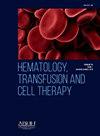FDG PET/CT AND PSMA PET/CT IN MUSCULOSKELETAL SOFT TISSUE SARCOMAS
IF 1.8
Q3 HEMATOLOGY
引用次数: 0
Abstract
Introduction/Justification
Soft tissue musculoskeletal sarcoma (STS) is a rare and varied class of mesenchymal-derived malignancies. Due to its histopathological heterogeneity and presence in different body locations, its diagnosis and treatment continue to present a significant medical challenge. In nuclear medicine, 18F-FDG PET/CT (FDG PET/CT) has been used to grade sarcomas, predict their prognosis, and assess therapy response. Although prostate-specific membrane antigen (PSMA) has been mainly used to detect prostate cancer metastases with PSMA PET/CT imaging and treat with 225Ac/177Lu-PSMA, this antigen has been shown to accumulate in non-prostatic tissues, including several types of sarcomas.
Objectives
Evaluate the potential of PSMA PET/CT in diagnosing different types of STSs compared to FDG PET/CT, with the aim of expanding the clinical management of these patients and the potential of a Theranostics strategy with radiolabeled PSMA.
Materials and Methods
Forty-four participants (20 females) with STS were prospectively enrolled and submitted to FDG PET/CT and PSMA PET/CT for primary staging, with a 48-hour interval between studies. SUVmax values were obtained in both studies of the primary STS lesion, locoregional lymph node metastases (LRLNs), distant lymph node metastases (DLNs), and bone metastases. SUVmax values among FDG PET/CT and PSMA PET/CT studies were normalized using the mediastinum SUVmax as a standard reference. The number of metastases detected by FDG PET/CT and PSMA PET/CT were also compared, as well as the absolute SUVmax values.
Results
The absolute SUVmax values were higher on PSMA PET/CT compared to FDG PET/CT, respectively for the primary STS lesions (18.5 vs 12.8), for LRLNs (8.0 vs 4.5) and bone metastases (8.7 vs 3.2), while these values were similar for DLNs (3.0 vs 4.0). When the SUVmax values were normalized using the mediastinum as a reference the ratio comparing PSMA PET/CT to FDG PET/CT showed, respectively: 10.3 vs 5.3 for the primary STS; 4.7 vs 2.0 for LRLNs; 4.8 vs 2.9 for bone metastases; and 1.7 vs 1.7 for DLNs. PSMA PET/CT detected more LRLNs compared to FDG PET/CT (10 patients vs 7 patients, respectively) and more bone metastases (5 patients vs 3 patients). The detectability of DLNs was equal in both studies (7 patients).
Conclusion
Our preliminary findings indicate that PSMA PET/CT is a potential diagnostic tool for staging sarcomas patients. Due to the high uptake in the primary STS lesions and metastases, there is a potential for a theranostics approach. This study received financial support from the São Paulo State Foundation for Teaching and Research Support (Cancer Theranostics Innovation Center, (CancerThera), CEPID FAPESP #2021/10265-8).
FDG pet / ct和psma pet / ct在肌肉骨骼软组织肉瘤中的应用
导言/理由软组织肌肉骨骼肉瘤(STS)是一种罕见的、多种多样的间充质衍生恶性肿瘤。由于其组织病理学异质性和存在于不同的身体部位,其诊断和治疗仍然是一项重大的医学挑战。在核医学中,18F-FDG PET/CT (FDG PET/CT)已被用于肉瘤分级、预测预后和评估治疗反应。虽然前列腺特异性膜抗原(PSMA)主要用于通过 PSMA PET/CT 成像检测前列腺癌转移和 225Ac/177Lu-PSMA 治疗,但这种抗原已被证明可在非前列腺组织中蓄积,包括几种类型的肉瘤。与 FDG PET/CT 相比,评估 PSMA PET/CT 诊断不同类型 STS 的潜力,目的是扩大这些患者的临床治疗范围,并评估放射性标记 PSMA 治疗策略的潜力。两项研究均获得了STS原发病灶、局部淋巴结转移(LRLN)、远处淋巴结转移(DLN)和骨转移的SUVmax值。FDG PET/CT 和 PSMA PET/CT 研究的 SUVmax 值以纵隔 SUVmax 作为标准参考值进行归一化处理。结果与FDG PET/CT相比,PSMA PET/CT的SUVmax绝对值在STS原发病灶(18.5 vs 12.8)、LRLNs(8.0 vs 4.5)和骨转移灶(8.7 vs 3.2)方面均高于FDG PET/CT,而在DLNs(3.0 vs 4.0)方面则与FDG PET/CT相似。以纵隔为参照物对 SUVmax 值进行归一化后,PSMA PET/CT 与 FDG PET/CT 的比率分别为原发性STS为10.3 vs 5.3;LRLNs为4.7 vs 2.0;骨转移瘤为4.8 vs 2.9;DLNs为1.7 vs 1.7。与 FDG PET/CT 相比,PSMA PET/CT 检测出更多的 LRLN(分别为 10 例患者对 7 例患者)和更多的骨转移(5 例患者对 3 例患者)。我们的初步研究结果表明,PSMA PET/CT 是对肉瘤患者进行分期的潜在诊断工具。由于 PSMA PET/CT 在 STS 原发病灶和转移灶中的高摄取率,有可能成为一种治疗方法。本研究得到了圣保罗州教学与研究支持基金会(Cancer Theranostics Innovation Center, (CancerThera), CEPID FAPESP #2021/10265-8)的资助。
本文章由计算机程序翻译,如有差异,请以英文原文为准。
求助全文
约1分钟内获得全文
求助全文
来源期刊

Hematology, Transfusion and Cell Therapy
Multiple-
CiteScore
2.40
自引率
4.80%
发文量
1419
审稿时长
30 weeks
 求助内容:
求助内容: 应助结果提醒方式:
应助结果提醒方式:


